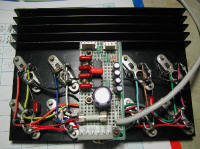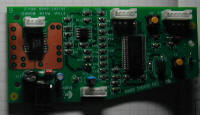
Also trim will affect the force that you have to apply to keep the aircraft level.
Joysticks with force feedback simulate these forces by applying two small motors that drive the X and Y axis of the stick. The flight simulator software knows the stick position, and depending on the aircraft flying condition, it calculates the force value (polarity and amount of motor drive) for each motor. This signal is send via USB to the FF joystick, and via a microcontroller and motor drive IC, both motors are driven.
Hacking a force feedback joystick is not much more difficult than hacking a normal USB joystick. It just takes some time to trace the schematics, check the motor drive IC signals, and draw everything up.
The simplified schematic of the Logitech Wingman Force Feedback 3D joystick is shown below.

Applying the force feedback to the home made yoke requires some more tinkering, but is definitely possible. The forces need to be much bigger than the small joystick motors can deliver, so bigger size motors are needed. These require more current as well, therefore high-current buffer circuits are added for driving the motors.
The FF motor drive IC is uses an H-bridge output for each motor. You could try to use the PWM square waves to drive a bigger H-bridge, but I opted for a simple class A buffer solution: The H-bridge PWM signals are transferred via RC networks into DC signals that are used to drive drive two push-pull emitter followers. This method will give more power dissipation, (~ 6 -7W per channel) but it is simple and noise free. As you will not be constantly pulling the yoke, average power dissipation is not very high.

Current buffers for driving bigger motors with hacked Logitech Force feedback joystick electronics
There are two resistors in each RC network that can be modified to get the right gain for each motor drive channel. Note: I used a high current Opamp L272. (often found on old H/D electronics) If you use a normal Opamp, you will need to use darlington power transistors.

Class A current buffer for driving force feedback yoke
For mechanical construction see Force
Feedback Mechanics and Flight Stick.
